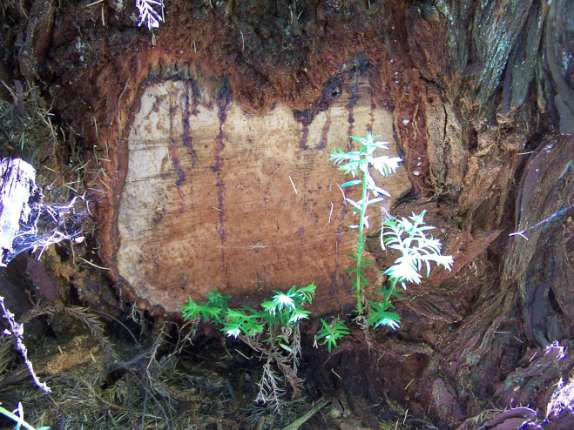Redwood burl poaching has long been an issue in the Redwood National Park in California, but now a staff person with the conservation group Oregon Wild has discovered burl poaching in a rare redwood grove in Southwest Oregon near Gold Beach, in the Rogue-Siskiyou National Forest.
“California took action against redwood burl poaching, but now the problem is spreading to Oregon,” observed Steve Pedery, Conservation Director for Oregon Wild. “Vandalizing these rare trees is not only a despicable act, it is a theft of Oregon’s natural heritage.”
Burls are tree growths where the grain has grown in an unusual way. Poachers target both live and dead trees with these growths, and sometimes cut down living redwood trees to access burls from higher up the stem. There is a growing black market for redwood burls, as well as burls from other old-growth trees. Burls are sold for ornamental furniture, veneer and souvenirs. The uncontrolled and illegal harvesting of burls directly threatens individual old-growth redwoods and the surrounding ecosystem.
Oregon’s fragile redwood groves are located in the Southwestern corner of the state, in the Rogue-Siskiyou National Forest. These redwood groves are largely pristine, but they lack Wilderness designation, or other strong legal protections. While poaching within Redwood National Park has generated national outrage, the US Forest Service has not responded as forcefully to illegal cutting on their lands. Conservation groups are alarmed that increased law enforcement on Park Service lands in California may drive the problem north into Oregon.
Oregon Wild is urging the Forest Service to reduce the risk of additional vandalism and poaching of redwood burls by stepping up law enforcement in the area. Abandoned logging roads pose a major problem in the area, as they are used by poachers to access redwood groves. Moreover, abandoned logging roads are often used to conduct other illegal activities, including marijuana grows and illegal dumping of waste. The simplest solution is to monitor and close the abandoned roads near redwood groves.
“The National Park Service took decisive action to protect their redwoods,” added Pedery. “The Forest Service needs to step up and take action now before redwood burl poaching becomes an epidemic in Oregon.”

Redwoods Burl Poaching, Rogue-Siskiyou National Forest. Photo: Wendell Wood, Oregon Wild
Facts About Redwood Burl Poaching
- When burls are cut from coast redwoods, it significantly injures the tree in different ways:
- Redwood bark provides a thick, insulating layer that protects the tree from insect infestation, fire and disease. By removing the bark and the cambium (the growing layer of the tree), the inner heartwood of the tree is exposed, increasing the risk of insect or fire damage and disease. The defacement of trees creates entry points for pathogens from which the tree may not recover.
- Since the burl is a primary tool for coast redwood reproduction, removing the burl may deny the tree its primary method of regeneration. A burl from a 2000 year-old coast redwood can initiate growth of a new tree that can live for another 2000 years, thus the Latin name for coast redwoods, Sequoia sempervirens, which means “forever living”.
- If the cuts are extensive, as has been in a number of cases, the structural integrity of the tree can be weakened to a point where it is threatened by high winds, floods, or saturated ground. In these situations, the canopy of the tree can also suffer extensive dieback and reduced vigor, further stressing the tree.

